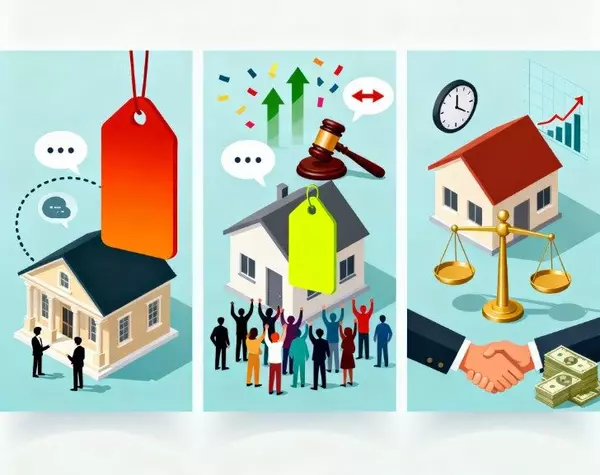Understanding Mortgage Points: Should You Pay to Lower Your Rate?
Understanding Mortgage Points: Should You Pay to Lower Your Rate?
When you are shopping for a mortgage, you will inevitably hear a lender ask: "Do you want to pay points to get a lower rate?"
In a high-interest rate environment, the offer sounds tempting. Who wouldn't want a 6.5% rate instead of a 7% rate? But that lower rate comes with a hefty upfront price tag.
"Buying down the rate" is essentially a gamble on how long you plan to keep the loan. If you guess right, you save thousands. If you guess wrong, you light money on fire.
Here is how mortgage points work, how to do the math, and how to decide if they are right for you.
What Exactly Are "Points"?
Discount Points (or simply "points") are fees you pay directly to the lender at closing in exchange for a reduced interest rate. You are essentially pre-paying interest upfront to lower your monthly payment for the life of the loan.
The General Rule of Thumb:
- 1 Point = 1% of your Loan Amount.
- 1 Point usually lowers your rate by 0.25%.
Example: On a $500,000 loan, 1 point costs $5,000. Paying that $5,000 might drop your interest rate from 7.0% to 6.75%.
(Note: The exact rate reduction varies by lender and market conditions, but 0.25% is the standard benchmark.)
The Golden Formula: Calculating the "Break-Even Point"
The only way to know if points are a good deal is to calculate the Break-Even Point. This is the moment in time when the monthly savings finally outweigh the upfront cost.
If you sell the house or refinance the loan before you hit the break-even point, you lose money. If you keep the loan past that point, you save money.
How to Calculate It:
Cost of Points÷Monthly Savings=Months to Break EvenA Real-World Example:
Let’s say you are borrowing $600,000.
- Option A (Par Rate): 7.0% Interest. Monthly P&I Payment: $3,991.
- Option B (Buying 1 Point): You pay $6,000 upfront to drop the rate to 6.75%. Monthly P&I Payment: $3,891.
The Math:
- Upfront Cost: $6,000
- Monthly Savings: $100 ($3,991 - $3,891)
- Break-Even: $6,000 ÷ $100 = 60 Months (5 Years)
The Verdict: In this scenario, you must keep this specific mortgage for 5 years just to make your money back. You only start truly "saving" money in Year 6.
When Does It Make Sense to Pay Points?
1. This is Your "Forever Home"
If you are buying the house you plan to retire in, and you never plan to move, paying points is a slam-dunk investment. Over a 30-year term, that 0.25% rate reduction will save you tens of thousands of dollars.
2. The Seller is Paying for It
This is the most common strategy in today's market. Instead of asking the seller to lower the price by $10,000, ask them for a $10,000 credit toward closing costs to buy down your rate.
- Why? A $10k price reduction lowers your payment by ~$60/month. A $10k rate buy-down could lower your payment by ~$200/month. It’s a better use of the seller's money.
3. The Break-Even Period is Short
Sometimes lenders run specials where the cost of points is cheaper. If the math says your break-even point is only 18 or 24 months, it’s a much safer bet.
When Should You AVOID Points?
1. You Plan to Refinance Soon
This is the biggest trap in the current economy. Many economists predict rates will drop in the next 12–24 months.
- The Risk: You pay $6,000 today to lower your rate to 6.75%. Next year, market rates drop to 5.5%. You refinance to get the 5.5% rate.
- The Result: That $6,000 you paid upfront is gone. You never reached the break-even point. If you think rates are trending down, do not pay points. Save your cash for the refinance later.
2. You Are Cash Poor
Don't drain your emergency fund just to save $40 a month. Liquidity is safety. It is better to have that $5,000 in the bank for a rainy day (or a broken water heater) than to have a slightly lower mortgage payment.
3. It’s a Starter Home
If you plan to upgrade to a bigger house in 3–5 years, you likely won't hold the loan long enough to recoup the upfront cost.
The Bottom Line
Mortgage points are simply a math problem. Before you agree to buy down the rate, ask your loan officer for a "Side-by-Side" comparison showing the cost vs. the monthly savings.
Run the break-even calculation. If it takes longer than 4 or 5 years to earn your money back, keep the cash in your pocket and take the slightly higher rate.
Categories
Recent Posts










GET MORE INFORMATION

